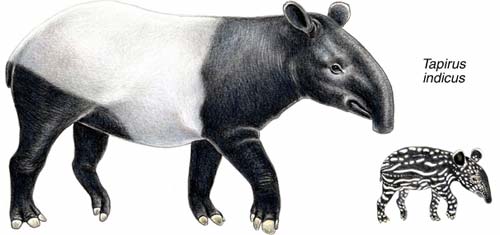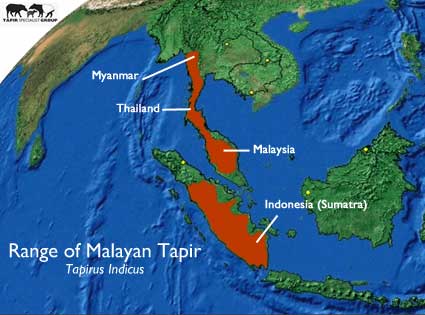Malayan Tapir
Tapirus indicus
Status: Endangered

Also Known As
badak (Malaysia and Indonesia), som-set (Thailand)
Characteristics
The Malayan tapir is the largest of the four species of tapir, and it’s the only one located in Asia. They are also the largest of the tapir species, weighing in at around 350 kg (720 pounds) and growing 1.8 meters long (6 feet).
These tapirs are easily recognizable by their coloration; they have a large white patch around their middles, and black heads and hind quarters.

Illustration generously provided by Stephen Nash, Conservation International
Habitat and Range
Malayan Tapirs are found from southern Thailand and southern Myanmar (Burma) through the Malayan Peninsula, as well as on the Indonesian island of Sumatra. Their habitat is rainforests and lower montane forests. They are able to inhabit secondary, regenerating native forests.
Malayan Tapir Range Map

Map by Carlos Pedraza, Tapir Specialist Group, 2008
Threats to Their Survival
Habitat destruction and fragmentation is the primary threat. Large scale deforestation, including illegal logging for timber, is a major source of habitat loss. The growth of palm oil plantations is also a major factor in habitat loss. Hunting is also on the rise as other large “prey” species in the area are reduced in number.
Population Estimate (2008): 1500-2000 individuals. Numbers are decreasing.
Other Malayan Tapir Facts
Primarily solitary, the species forms occasional associations for breeding.
Communication is by a range of whistles of different pitch and duration.
The malayan tapir is more active throughout the night but is often seen during the day, including feeding.
There is no evidence of exclusive territoriality. Males appear to have small home ranges (about 1-2 sq km) and females possibly range more widely.
Malayan tapirs eat the twigs and growing tips of a wide range of understory vegetation, including snapping small to large saplings with their mouths to get to plant parts that are out of reach. They also eat a wide variety of fruits and leaves from the forest floor.
They are vulnerable to predation by tigers. Their defense mechanism is to run through thick vegetation. Malayan tapirs have very thick and tough skin, particularly on their hindquarters. They also have a powerful bite.
A lot is still unknown about this species.
